
|
Manifest Technology Making Sense of Digital Media Technology By Douglas Dixon |
|
|
Articles: | PC Video | Web Media | DVD & CD | Portable Media | Digital Imaging | Wireless Media | Home Media | Tech & Society | PC Video: | PC Video Articles | Video Software Gallery | Video Editing Resources | Connecting Video To Your PC:
|
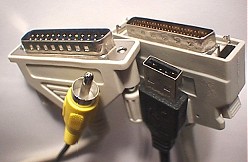 |
PC cables and connectors: - Parallel, SCSI |
The past couple of years have seen an explosion of new and relatively inexpensive choices for capturing video on your PC. These range from inexpensive home desktop cameras that capture small clips for under $100, to external capture boxes for around $200, to higher-end capture boards that can handle full-size full-rate video for up to $1000.
As usual for PC's, you have a lot of choices within this range. This is especially true because PC's have lots of different ways to plug in additional equipment, and these days there's a video capture solution for almost any of them. Your options include all those different-sized connectors on the back of your PC box (parallel and USB), high-speed connections (Firewire and SCSI) plug-in PCI boards (analog capture), as well as PC cards for laptops.
What's right for you depends on several factors: what you want to do with the video (create small Web clips or do full professional editing), why and how you want to use video (videoconferencing at your desktop or vacation scenes with your camcorder), and which of those different plugs you want to capture through. We'll discuss these different options for the kind of equipment you want to use and the type of video you want to work with, and then detail the trade-offs for different kinds of video capture devices for each type of PC connection.
These products are often sold in different configurations for specific uses, and including additional hardware like a bundled camera or extra bundled software. Depending on what you want to do with video on your PC, you may want a capture product designed for video conferencing (with bundled communications software), TV viewing (with TV and radio tuners), or with video editing and effects software. You may also want to check for other special hardware features, including integrated audio capture, a s-video connector for higher-quality analog video input, and hardware compression, especially into standard formats such as Motion JPEG.
The most basic decision for using video on your PC is what kind of camera you want to use. If you're most interested in videoconferencing or capturing video clips of materials around your desktop, the simplest solution is to buy a digital desktop camera that plugs directly into your PC. These desktop cameras combine the camera imager and capture hardware in one all-digital unit, so they can be small and expensive.
If you already have a camcorder, or want to shoot video clips at events or on trips, then you need an adapter box or board for your PC so you can bring your camcorder back to your PC, plug it in, and capture the video clips. This solution provides a more flexible solution for capturing video from different sources, and provides a wide range of options (and prices) for capturing higher-quality video.
To get video into your computer, you need to connect up some plumbing. The easiest option, for both desktop PC's and laptops, is to plug in to one of the open ports on the back of your computer. All PC's have at least one serial port and one parallel port, and PC's made in the past year now have at least one USB port.
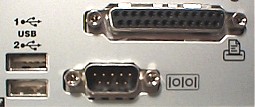 |
PC ports and connectors: - 2 USB (like phone
jack) |
Serial ports were traditionally used for modems and computer-to-computer communication at relatively low data rates. The COM1 device on your PC can typically be configured at speeds up to 921,600 bits per second, or 115,200 bytes per second (115.2 KB/sec). Parallel ports are still used mostly for printers, but have been extended over the years to provide two-way ("bi-directional") communication, with higher data rates. If your PC is configured properly, an enhanced (ECP/EPP) parallel port can provide up to 2 MB/ sec, which is enough of a pipe to do interesting video.
The use of the parallel port for desktop video was popularized by the Connectix QuickCam (now sold by Logitech), an inexpensive "eyeball" digital video camera. There are now multiple versions of the QuickCam and similar products for videoconferencing and desktop use, at street prices down to $80. Many of these products are available in both parallel and USB versions.
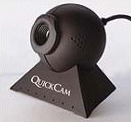 |
Logitech / Connectix QuickCam: Digital desktop video camera |
The difficulty with parallel products is that your parallel port is typically already in use for your printer (and maybe also a scanner), so you may need to swap devices, or make sure you get a camera which has a pass-through to hook up your printer at the same time. Even so, the parallel port was not really designed for sharing in this way, and your system can get confused if you try to do more than one thing at a time with it.
Newer PC's now also include USB (Universal Serial Bus) ports. The USB specification was explicitly designed for sharing multiple devices such as scanners and input devices. With a data rate of 1.5 MB/sec, it can support digital audio and compressed video. USB also is a lot more convenient to use: you can plug in and remove devices while the PC is running, and it provides power so small devices do not need a separate power supply.
A variety of desktop USB digital video cameras are now available for around $150, with a wide selection of resolutions and video formats. Some of the earliest products introduced last year included the Kodak DVC's and the Intel Create and Share Camera Pack.
 |
 |
Intel Create and Share Camera Kodak DVC 300 |
If you want capture video of the outside world from your camcorder, and not just from a dedicated desktop camera, you can still use the parallel and USB ports to feed video into your PC. Products like the Logitech (Connectix) QuickClip are small external video capture adapters that connect to your PC. Just plug in an analog video cable from your camcorder or VCR and you can view and capture analog video.
|
|
Like the dedicated digital cameras, however, your video resolution and quality is limited by the bandwidth of the parallel or USB port to 1 - 2 MB/sec. This is not a very wide pipe: "full-resolution" video is typically captured at 640 x 480 resolution, 640 pixel dots across by 480 lines of pixels down. Just one frame of video is 900 KB of data, and one second of video at 30 frames per second is over 26 MB/sec. Reducing to 320x240 resolution reduces it to a quarter the size, or around 6.6 MB/sec. Reducing to 160x120 resolution gets down to 1.6 MB/sec, which is in the ballpark for these pipes. You can also accommodate larger video resolutions by a combination of other approaches, including lowering the frame rate from 30 to 15 to 10 to even 5 frames per second, reducing the pixel size from 24-bit to 16-bit, and reducing the color data to half or one-third the original size.
As a result of the limitations of the parallel and USB pipes, some of these video cameras and adapters also have built-in compression hardware with custom compression algorithms. A logical extension of this idea is to build a slightly more expensive external box with more hardware to do standards-based compression. For around $200 - $300 you can plug in to your parallel port and do analog video capture directly into the M-JPEG or MPEG standards. The first products of this type included Dazzle Multimedia and Videonics Python.
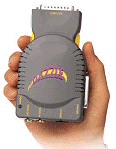 |
Dazzle Multimedia: Analog compressed video capture |
The newest interface for PCs is FireWire, or IEEE 1394. This interface is designed for the needs of digital video (DV) cameras, with data rates of 12 to 25 to 50 MB/sec in the first versions. Hooking up a DV camcorder to your PC currently requires a PCI adapter card, but FireWire is starting to be built in to PC designed for audio/video use from companies like Sony.
Another possible external connector for your PC is the SCSI (Small Computer Systems Interface) port, which is typically used for high-performance disks. You can buy PCI SCSI adapter cards from companies like Adaptec that also allow you to have a faster connection to external devices like removable disks and CD-ROM drives.
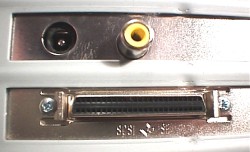 |
PC video ports and connectors: - Analog video |
Since the SCSI interface can support multiple devices at data rates from 5 to 10 to 20 to 40 MB/sec, it offers interesting possibilities for video capture. Iomega has introduced one such product, the Buz, to join their Zip and Jaz removable disk products.
 |
Iomega Buz: SCSI video capture |
The bottom line for video capture, however, is that if you want the best performance, you do not want to hook up to an external pipe outside your PC. You need to hook in directly to the big wide pipes on your system bus, which requires opening up your PC to install a capture board in one of the slots. The PCI (Peripheral Component Interconnect) bus provides data rates of around 100 MB/sec direct to your system memory and display. With PCI boards, you can capture full-size full-rate video clips, limited only by your disk speed.
As usual, there are a wide variety of products available, from plain video capture to video conferencing to TV tuners, at prices ranging from $99 to around $150. These include product families from companies like Winnov, products with bundled cameras like the 3Com (USR) Big Picture and the Intel Create and Share Camera Pack, TV tuner cards from companies like Hauppauge, and TV tuners integrated with video display cards from companies like ATI and Matrox.
|
|
|
Laptop owners can use the external parallel and USB cameras and video capture adapters, or can choose from a variety of PC cards for video capture. Like the PCI bus for desktop PC's, the PC card PCMCIA interface allows the capture hardware to provide a higher data rate by connecting directly into the system bus. Companies like Nogatech and Winnov provide several versions of PC card video capture products and small bundled cameras, including digital cameras, capture from analog cameras, TV tuners, and audio capture for videoconferencing.
|
Nogatech PC card |
With all these possibilities, you too can do video on your PC. You can even do it without having to open up your PC. For under $100 you can plug in a digital camera, or connect up your analog camcorder and capture video clips through your parallel or USB port. However, since these pipes are not very wide, your video will be limited in resolution and frame rate, and suitable mainly for video conferencing, sharing small clips, and posting on the Web. For around double the cost, you can get external M-JPEG/MPEG capture boxes which are great for standards-based video editing.
If you want more flexibility, larger frame sizes, and better frame rates you'll need to open up your PC to install a PCI board to install a wider video pipe. For around $100 you can capture full-size video clips, or you can step up to TV tuners or more professional boards with higher video quality and built-in standards compression.
Even laptop users can now be doing video, using the same external parallel or USB devices, or with a plug-in PC card. Road warriors can make video trip reports, or videoconference to work (or to the kids at home).
Pick your plumbing, and dive on in!
|